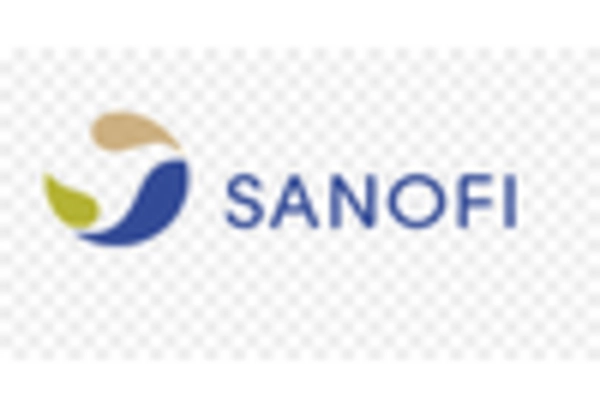Growing Awareness and Education
The rising awareness and education surrounding hormonal disorders are driving the Antiandrogens Market. Patients are becoming more informed about their health, leading to increased consultations with healthcare professionals regarding treatment options. Educational campaigns and resources provided by healthcare organizations are playing a pivotal role in this trend. As individuals learn more about conditions like polycystic ovary syndrome and prostate cancer, they are more likely to seek antiandrogen therapies. This heightened awareness is reflected in the growing number of prescriptions for antiandrogens, indicating a shift in patient behavior towards proactive health management. Consequently, the Antiandrogens Market is experiencing a positive impact as more patients pursue effective treatment solutions.
Advancements in Drug Development
Innovations in drug development are propelling the Antiandrogens Market forward. Recent advancements in pharmaceutical technology have led to the creation of more effective and targeted antiandrogen therapies. These developments are not only enhancing the efficacy of existing treatments but also reducing side effects, which is a critical concern for patients. The introduction of novel compounds and delivery systems has the potential to revolutionize treatment protocols for conditions like androgenetic alopecia and hormone-sensitive cancers. Market data suggests that the antiandrogens segment is expected to witness a compound annual growth rate of over 6% in the coming years, driven by these advancements. As pharmaceutical companies invest in research and development, the Antiandrogens Market is poised for substantial growth, reflecting the ongoing commitment to improving patient outcomes through innovative therapies.
Increasing Investment in Healthcare
The surge in healthcare investments is significantly influencing the Antiandrogens Market. Governments and private entities are allocating more resources to healthcare, particularly in the field of endocrinology and oncology. This influx of funding is facilitating research initiatives aimed at understanding hormonal disorders and developing effective antiandrogen treatments. For instance, several countries have reported increased budgets for healthcare research, which has led to a rise in clinical trials for antiandrogens. This trend is expected to enhance the availability of new therapies and improve patient access to treatment options. As a result, the Antiandrogens Market is likely to benefit from this increased investment, fostering an environment conducive to innovation and growth in the sector.
Regulatory Support for Antiandrogens
Regulatory bodies are increasingly supporting the development and approval of antiandrogens, which is a crucial driver for the Antiandrogens Market. Streamlined approval processes and favorable regulations are encouraging pharmaceutical companies to invest in antiandrogen research. Recent initiatives aimed at expediting the review of new therapies have resulted in a more efficient pathway for bringing innovative antiandrogens to market. This regulatory support not only enhances the speed of drug availability but also fosters competition among manufacturers, ultimately benefiting patients through improved access to treatment options. As regulatory frameworks continue to evolve, the Antiandrogens Market is likely to see a surge in new product launches, further stimulating market growth.
Rising Incidence of Hormonal Disorders
The increasing prevalence of hormonal disorders, such as polycystic ovary syndrome and prostate cancer, is a primary driver of the Antiandrogens Market. As awareness of these conditions grows, more patients seek effective treatments, leading to a surge in demand for antiandrogens. According to recent estimates, the incidence of prostate cancer has been rising steadily, with projections indicating that it could affect one in eight men. This trend underscores the necessity for effective antiandrogen therapies, which are crucial in managing these disorders. Furthermore, the rising incidence of hormonal imbalances among women, particularly in reproductive health, has prompted healthcare providers to explore antiandrogens as viable treatment options. Consequently, the Antiandrogens Market is likely to experience significant growth as healthcare systems adapt to meet the needs of this expanding patient population.

















Leave a Comment